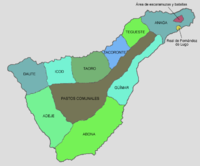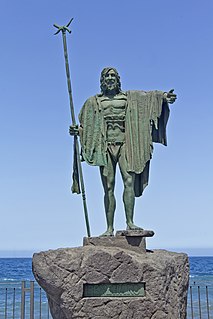
Tacoronte was one of nine menceyatos guanches (native kingdoms) in which the island of Tenerife (Canary Islands, Spain) was divided at the time of the arrival of the conquering Spaniards.

Guanches were the aboriginal inhabitants of the Canary Islands. In 2017, the first genome-wide data from the Guanches confirmed a North African origin and that they were genetically most similar to modern North African Berber peoples of the nearby North African mainland. It is believed that they migrated to the archipelago around 1000 BCE or perhaps earlier.

Tenerife is the largest and most populated island of the seven Canary Islands. It is also the most populated island of Spain, with a land area of 2,034.38 square kilometres (785 sq mi) and 904,713 inhabitants, 43 percent of the total population of the Canary Islands. Tenerife is the largest and most populous island of Macaronesia.

The Canary Islands is a Spanish archipelago and the southernmost autonomous community of Spain located in the Atlantic Ocean, 100 kilometres west of Morocco at the closest point. The Canary Islands, which are also known informally as the Canaries, are among the outermost regions (OMR) of the European Union proper. It is also one of the eight regions with special consideration of historical nationality recognized as such by the Spanish Government. The Canary Islands belong to the African Plate like the Spanish cities of Ceuta and Melilla, the two on the African mainland.
It occupied an area significantly greater than the current city of Tacoronte, including La Matanza de Acentejo and El Sauzal.

Tacoronte is a city and municipality of Tenerife, Canary Islands, Spain. It is located in the north-east of the island. Mostly rural, the municipality stretches for 30 square kilometers from the volcanic peaks that rise in the center of the island to the Atlantic shore. The municipality seat, also called Tacoronte, lies about 16 km west of the capital, Santa Cruz de Tenerife. Old manorial houses and farms are situated here, as well as vineyards that produce the wine known as Tacoronte-Acentejo.

La Matanza de Acentejo is a town near the north coast of Tenerife, Canary Islands, Spain. It is located 10 km east of Puerto de la Cruz, and about 20 km west of the island's capital, Santa Cruz de Tenerife. Its name means "the Slaughter of Acentejo" in Spanish, and refers to the 1494 First Battle of Acentejo, lost by the Spanish.

El Sauzal is a town and a municipality in the northeastern part of the island of Tenerife, Canary Islands, Spain. It is located on the north coast, 12 km west of San Cristóbal de La Laguna, 13 km northeast of La Orotava and 18 km west of the island's capital, Santa Cruz de Tenerife. The TF-5 motorway passes through the municipality. The population is 9,076 (2013) and the area is 18.31 km².
It is believed that the first Mencey of Tacoronte may have been Rumén or Romén, later succeeded by his son Acaimo. [1]

Acaimo or Acaymo was a Guanche mencey of Tacoronte, on the island of Tenerife at the time of the Spanish conquest in the 15th century. He formed an alliance against the Spaniards with the mencey Beneharo and the mencey Bencomo.






